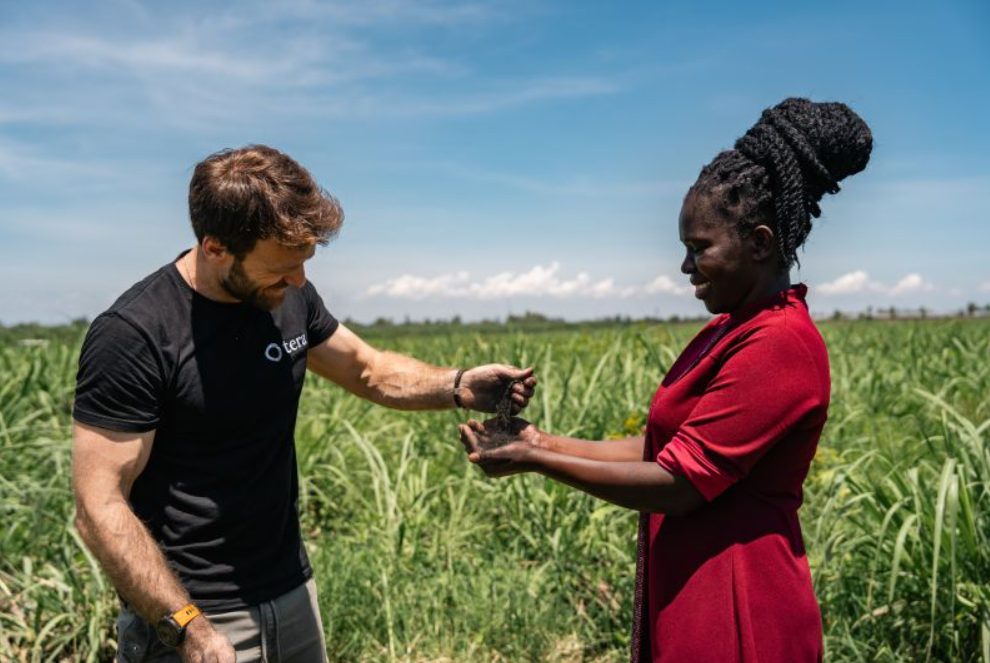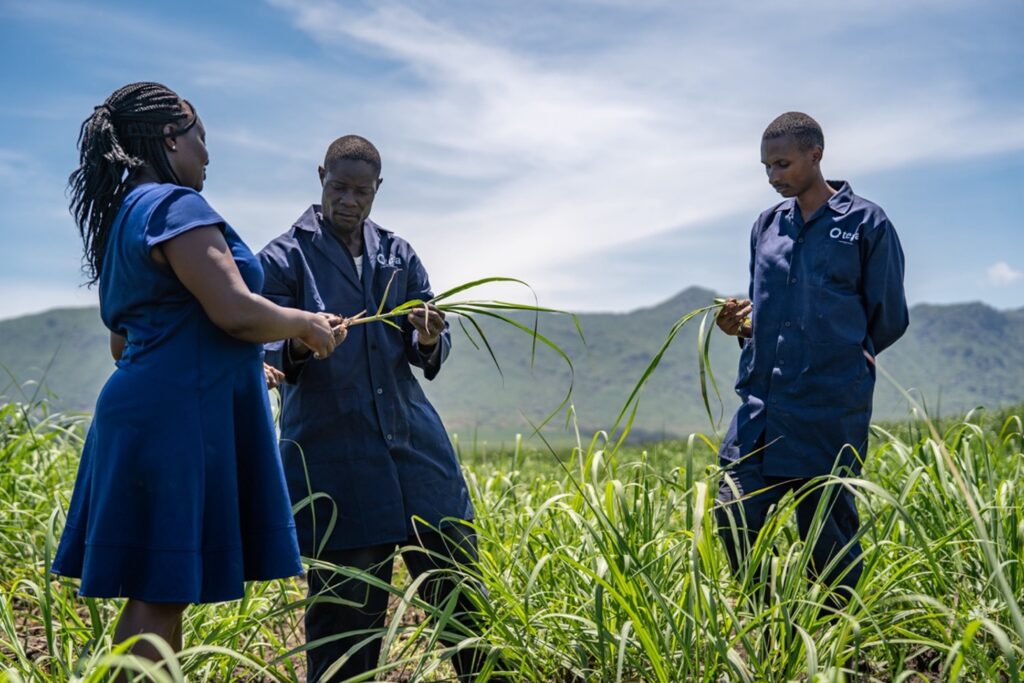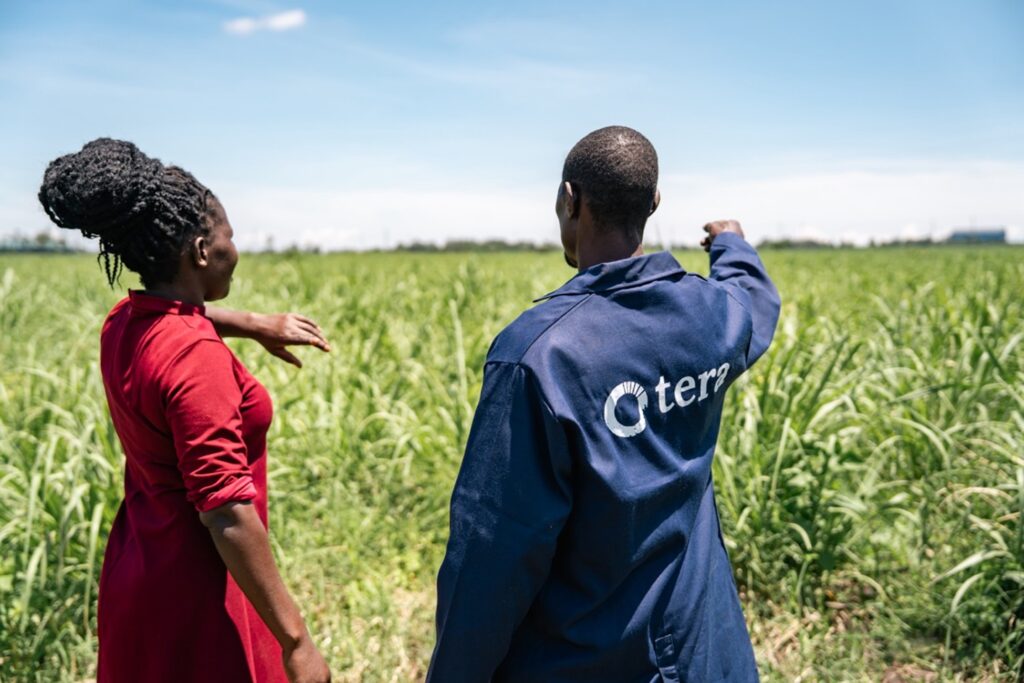Tera: Upcycling Sugar Cane Bagasse into Biochar
Rob Palmer (left), co-founder and CEO of Tera, with a Tera employee (Photo courtesy of Tera)
The production of biochar in Africa could reduce carbon in the atmosphere and provide farmers with a solution to soil degradation in the region. Tera Carbon is testing biochar production in Kenya, Africa to prove that biochar can be an effective method to stabilize the climate and improve soil production in Africa.
Biochar is a solid form of carbon produced from burning organic material and/or waste in the absence of oxygen, a process known as pyrolysis. Aside from trapping carbon, biochar can increase water holding capability in the ground and improve nutrient availability to plants. Thus, it can be used as a soil amendment to help promote water irrigation, along with water and nutrient retention, according to the USDA.
One material used to create biochar is sugar cane bagasse, the waxy remains of crushed sugar cane. Africa alone produces around 95 million tons of sugar cane annually and stockpiles the bagasse. The intensive farming in the region leaves the soil infertile and unable to hold water while the stockpile of bagasse adds to the carbon problem, said Rob Palmer, CEO and co-founder of Tera.
“In most African countries agriculture is the key industry, not just for feeding the population but contributes massively to national prosperity. The soils are so degraded that they are unable to support this industry. Without intervention, we could see a decline that would decimate entire populations. This is a global humanitarian time-bomb,” Palmer said in an email.
Biochar is one solution to the soil degradation problem in Africa and a carbon removal method that Palmer is familiar with. Before co-founding Tera, Palmer worked on biochar and enhanced rock weathering for The Future Forest Company and later Undo Carbon. While Palmer primarily focused on enhanced rock weathering at the two companies, the “biochar bug” never left him and he still sees it as an “incredibly powerful agronomic and climate tool.”
Later on in his career, Palmer met his future co-founder Jim Mann, who, at the time, ran the largest renewable biomass business in East Africa. Mann’s project focused on converting sugar cane bagasse into biomass fuel through briquetting and selling it as a replacement for wood and oil, Palmer said.
Palmer recommended to Mann that he should use the sugar cane bagasse for biochar instead due to the capabilities of the material. The two co-founded Tera in 2024 and planned their biochar production project.
The Biochar Project
Tera Carbon began their pilot project in 2024 with the goal of upcycling the sugar cane bagasse into biochar. Palmer said he chose to set up the project in Kenya because of all the sugar cane mills in the region. This meant that the team had a vast supply of sugar cane bagasse.
“There are about 10 to 14 mills in the West Kenya region, and production of bagasse, the waste material of the sugar cane… is somewhere in the region of 1.2 to 1.6 million tons a year, and that has no other use,” Palmer said. “It is just stockpiled, causing an ecological issue. So we convert that waste into biochar.”
Once on site, the team set up a small pyrolysis machine, which turns organic material into biochar. Also on site is a Measuring, Reporting and Verifying (usually abbreviated to “MRV”) outcomes monitoring platform. This platform monitors and records the temperature of the pyrolysis machine, the carbon percentage in the biochar, and other crucial date points, said Marcus Tressler, Head of Operations for Tera.
“For us to know what type of biochar we have, we need to measure the temperature that we’re making our biochar at,” Tressler said. “That’s why we are doing that in real time. And then we have built a platform… for all of that data we’re recording to monitor, report and verify our project.”
Biochar production requires a pyrolysis machine, an oven that has a sealed chamber deprived of oxygen. Dried bagasse is fed through the machine and into the sealed chamber, where it is pyrolyzed and turned into biochar. Afterward, the biochar is doused in water to prevent combustion and quickly stored, Tressler said.
Now that the pilot phase is done, Tera is looking at upscaling their first site and getting the project approved for carbon credits. For the upscaling process, Palmer said that the project site will acquire bigger and more pyrolysis machines to increase the production of biochar. All of this will be factored into the carbon offsets as they continue production.
Lastly, Palmer is looking at getting the project approved for Carbon Dioxide Removal (CDR) credits, a type of carbon credit that represents an amount of carbon removed from the atmosphere. To obtain these credits, an organization must submit a project design document to the Validation/Verification Bodies (VVBs) for approval.
Once the VVB approves a project, the organization must package and send their collected data to the VVB to show compliance to the methodology in retrospective. The VVB will look over the submitted data to ensure that the project complied with the relevant carbon removal methodology, he said.
If the VVB verifies the project, they will send the organization verified carbon credits. From there, the organization can sell the credits on the carbon market and earn revenue for the project, Palmer said.
The Carbon Market
Biochar production is one method companies can use to remove carbon from the atmosphere and produce carbon credits or offsets. Carbon credits and offsets are traded in two separate markets, with the former heavily regulated by the government and typically associated with cap-and-trade systems. In contrast, carbon offsets are purchased in the voluntary market and include carbon sequestering efforts like biochar, enhanced rock weathering and other emission reduction projects.
In the first quarter of 2024, biochar became very popular on the CDR market, and according to CDR.fyi, “biochar accounted for 46% of total number of (carbon credit) transactions, also representing 80% of all [CDR] deliveries in Q3 2024.”
With the carbon credits obtained by producing biochar, Tera can make a profit, which they can use to expand their projects across the region. Palmer’s goal is to continue expanding across Kenya and then East Africa.
Palmer said he will continue to expand the biochar project across all of Africa, but does not have a fixed endpoint in mind. Instead, he hopes to focus on the impact and scale of the biochar project.
Grey Kamasz is a science writer with expertise in environmental science, sustainability, and climate change. Kamasz holds a Master’s in Journalism from the University of Oregon. With experience writing for university newspapers, he developed journalism skills and helped cover many projects across campuses. Kamasz worked on coverage for an undergraduate research fair at Washington State University and the Thermal Heating System Transition at the University of Oregon.
Support us on Patreon
Thank you for joining us today! Please become a member of RTE and support us on Patreon. Unlike many larger organizations, we work with a team of determined and passionate volunteers to get our message out. We aim to continue to increase the awareness of remineralization to initiate projects across the globe that remineralize soils, grow nutrient dense food, regenerate our forests’ and stabilize the climate – with your help! If you can, please support us on a monthly basis from just $2, rest assured that you are making a big impact every single month in support of our mission. Thank you!











Got something to say?